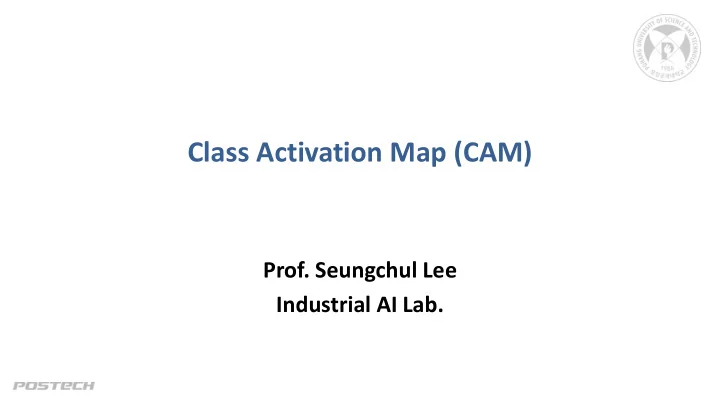

Class Activation Map (CAM) Prof. Seungchul Lee Industrial AI Lab.
Issues on CNN (or Deep Learning) • Deep learning performs well comparing with any other existing algorithms • But works as a black box – A classification result is simply returned without knowing how the classification results are derived → little interpretability • When we visually identify images, we do not look at the whole image • Instead, we intuitively focus on the most important parts of the image • When CNN weights are optimized, the more important parts are given higher weights • Class activation map (CAM) – We can determine which parts of the image the model is focusing on, based on the learned weights – Highlighting the importance of the image region to the prediction 2
Visualizing Convolutional Neural Networks • Class Activation Maps (CAMs) • A class activation map (CAM) for a given class highlights the image regions used by the CNN to identify that class B. Zhou, A. Khosla, A. Lapedriza, A. Oliva, and A. Torralba. 3 Learning Deep Features for Discriminative Localization. CVPR'16
Fully Connected Layer Convolution Max pooling 7 9 Convolution and pooling layers Fully connected layer Classification Convolutional Neural Networks 4
Global Average Pooling • Class Activation Map (CAM) • (or Attention) learned Convolution Max pooling k Class Activation 2 Map 1 7 sigmoid x y , 9 Convolution and pooling layers Global Average Pooling Classification Convolutional Neural Networks B. Zhou, A. Khosla, A. Lapedriza, A. Oliva, and A. Torralba. 5 Learning Deep Features for Discriminative Localization. CVPR'16
Global Average Pooling Implementation (Naïve) k 2 1 7 sigmoid 7 x y , 9 sigmoid 9 6
Global Average Pooling Implementation (Better Way) k 2 1 7 sigmoid x y , 9 7
Global Average Pooling Implementation (Exactly) k 7 softmax x y , 2 9 softmax x y , 1 8
Example: MNIST 9
Cantilever In collaboration with KIMM 10
Cantilever In collaboration with KIMM 11
Recommend
More recommend